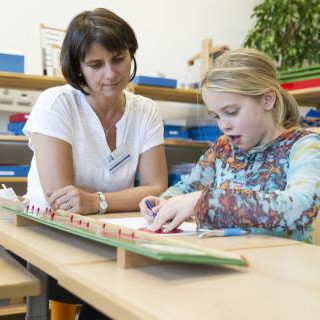 The Bilingual Montessori School is based on the reformed pedagogical principles of Montessori education and implements them in the best possible way.
The Bilingual Montessori School is based on the reformed pedagogical principles of Montessori education and implements them in the best possible way.
The BMS teaches in inter-year classes.
We do not see the existing differences in the learning development of our pupils as deficits, but rather view each child in their individuality as a person with strengths and weaknesses. Learning is not hindered, but enriched by the different knowledge and levels of development of each individual.
In shared lessons, our pupils learn to appreciate diversity. They benefit from the special abilities and experiences of others.
Our pupils
- grow into an existing class community,
- adopt existing rituals and agreed rules,
- experience a change of perspective during their time at school, from seeking help to helping others,
- experience the differences in personal development, their own level of learning and their own interests as normal.
Free work
The principle of free work / free choice of work according to Maria Montessori means that the pupil can decide for himself when he/she wants to work and for how long. The independent handling of the material gives the child the opportunity to acquire their own working rhythm and develop their own individual learning pace. The child is free to repeat the activity as often as they wish.
However, the free choice of work does not mean unlimited freedom, which is made clear by the top rule: "My freedom ends where your freedom begins."
The children and young people become increasingly independent, and take responsibility for their actions. They learn to work together, talk to each other, solve problems, help each other, show consideration for each other, and handle learning materials with care.
Cosmic education
For Maria Montessori, cosmic education is the cornerstone of pedagogy, and is intended to give children and young people guidance. Maria Montessori starts from the big picture and then studies the details. Our pupils should not learn unrelated detailed knowledge from different subject areas (mathematics, science, history, ...), but we want to offer them a "universal" curriculum. In concrete terms, this means that we use excursions, experiments, presentations and stories to awaken the pupils' curiosity about learning, stimulate their imagination and show them the overall context.
Prepared environment
The prepared environment is an important and necessary component of Montessori education. The school environment is designed in such a way that the pupils can find their own way around, and all the materials they need to work and learn independently are available in the classrooms. This is the only way to give pupils the opportunity to gradually detach themselves from adults, and acquire the skills they need to be independent. In the sensitive phases, pupils should receive learning stimuli from their environment, which is why particular attention must be paid to how the environment is designed. The learning guide is responsible for the prepared environment. Everyone is required to maintain it.
Each class has materials that correspond to the respective developmental stage. These materials are visible on the shelf at the child’s eye level. Their appearance and their placement in the room give the material a stimulating character. There is only one set of each specific material, so that the children learn to be considerate. With Montessori, the children are free to choose which material they want to work with, according to their stage of development. As soon as the educator or teacher identifies an interest, they "offer" it to the child. He (they?) then introduces the child to the use of the material.
Montessori divides the material into five learning areas:
- Exercises of daily life
- Sensory material
- Math material
- Language material
- Material on cosmic education
Trevor Eissler, American author, pilot and Montessori father of three children, offers an impressive explanation of the convincing approaches of Montessori education in his Simple Show Movie "Montessori Madness" and in numerous interviews and books. Find out more.